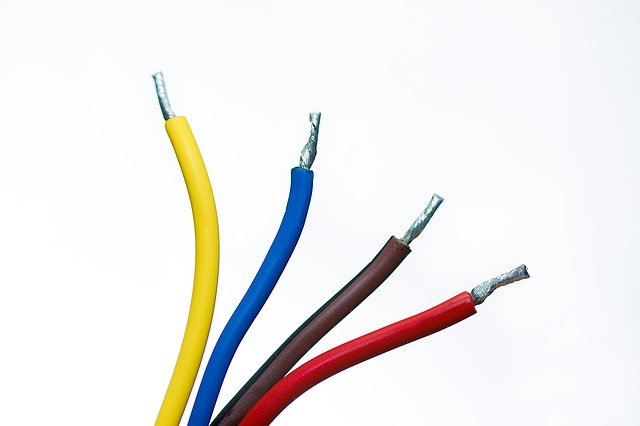Calculate line cross section - Calculate Now
Why using the right cable cross-section is necessary in the first place
Electron movements caused by electrical voltage always generate heat in the corresponding cable. The greater the number of electrons set in motion, the greater the current voltage and ultimately the greater the heat generated in the cable.
In order to avoid potential accidents due to cable fire or cable breakage, for example, the respective power line should also have a sufficient line cross-section. The level of voltage required by the power device is decisive here.
For example, a doorbell system at the front door requires a smaller cable cross-section than, say, an oven.
Potential damage due to undersized cabling
If an appliance with a large power requirement were to be operated with undersized power wiring, a cable fire would be virtually preprogrammed. In this context, it is the task of the electrician, or engineer, to ensure adequate wiring.
In addition to the accidents mentioned above, damage to the cabling caused by heat generation or short circuits can also lead to damage to the device itself. In the worst case, the owner is liable for this himself, if this causes major damage to the apartment or house, which the liability insurance does not cover due to personal negligence.
In addition to the use of an expert and demonstrably trained electrical engineer, the use of the appropriate cable cross-sections should be considered above all. Which cable cross-section is exactly needed for which project, a little more information on this in the following sections.
The mathematical background for calculating the cable cross-section
Especially for 12 V as well as for 24 V circuits, it is important to use the correct cable cross-section. For this purpose, the listing of the formula for calculating the electrical power should serve as a starting point:
P = U x I
P is the electrical power in the unit Watt (short: "W"). This is calculated by multiplying the voltage U in volts (or "V" for short) and the current in I in amperes (or "A" for short).
If, for example, a television is to be operated at 1,000 W and two voltages of 12 V and 230 V are available for this purpose, this results in two different amperages required:
I = 1,000 W / 12 V = 83.33 A
I = 1,000 W / 230 V = 4.35 A
In the first case, a power line with a higher cross-section is required to operate the TV, since a much higher amperage is needed here for operation.
Formula for calculating the line cross-section
With the help of the following formula components, the required line cross -section can finally be calculated:
| Physical quantity | Unit | Formula symbol | What is it? |
| Line length | m | L | Enter the exact length of the power line to be used here |
| Mains voltage | V | U | The prevailing voltage in the respective network (varies from country to country) |
| Power | kW | P | Enter the power of the end device to be operated here |
| Cosine | 0.9 to 1.0 | φ | Corresponds to the power factor, which specifies the ratio between active and apparent power |
| Voltage drop | % | Ua | Difference in the current voltage between the power source and the point of consumption (caused, for example, by cable losses). |
| Conductivity | S/m | y | The conductivity value of the respective material (e.g. copper) is to be entered here. |
The formula for calculating the required cable cross-section is thus composed as follows:
Line cross-section alternating current(A) = 2 x L x I x φ / (y) x Ua.
Required conductor cross-section is different for each material
The actual conductor cross-sections required vary from material to material. For example, the material copper has a higher conductivity than the material aluminum. Other influencing factors such as direct, alternating or three-phase current also cause differences in the required conductor cross-section.
The precious metal silver has the highest of all known conductivities. Another parameter is the chaining factor, which is exactly 1.732 for three-phase current - this provides information about the voltage ratio of two neighboring outer conductors.
Overall, this results in different line cross-sections depending on the initial situation.
Use the practical online calculator now to calculate the required cable cross-section
With the help of the practical online calculator, you can now quickly and easily calculate the cable cross-section required for the project in question. All you need for this are the corresponding key figures. These must be entered into the free calculator tool.
Important information that you should have ready for the use of the online calculator is the type of material (for example, copper or aluminum) as well as the cable length used in meters, which should be measured exactly.
Furthermore, you should know the prevailing voltage in the connected power grid as well as the efficiency of the system and the current strength. Furthermore, find out what type of current is involved - for example, direct current, alternating current or three-phase current.
Once you have gathered all the information and made a note of it, you can conveniently enter the parameters and information into the online calculator. At the push of a button, the online calculator tool will then calculate the cable cross-section required for your individual project.
But you can also use the free cable cross-section calculator tool for checking purposes
In addition to the preparatory calculation method, you can also use the advantageous online calculator to check your power lines afterwards. Find out whether your individual equipment has been equipped with adequate power lines or check the feasibility of your individual project.
Use your power lines only up to the maximum current in any case
Current-carrying lines may only be used up to the maximum permissible amperage. Furthermore, these must be protected by an additional fuse to prevent damage due to overvoltage (for example, cable fire, cable breakage or equipment damage).
In this context, the use of the necessary fuse capacities must also be checked.
Similar Calculator Topics: Electrics, electrical engineering, building services, construction, engineers, converter, convert


